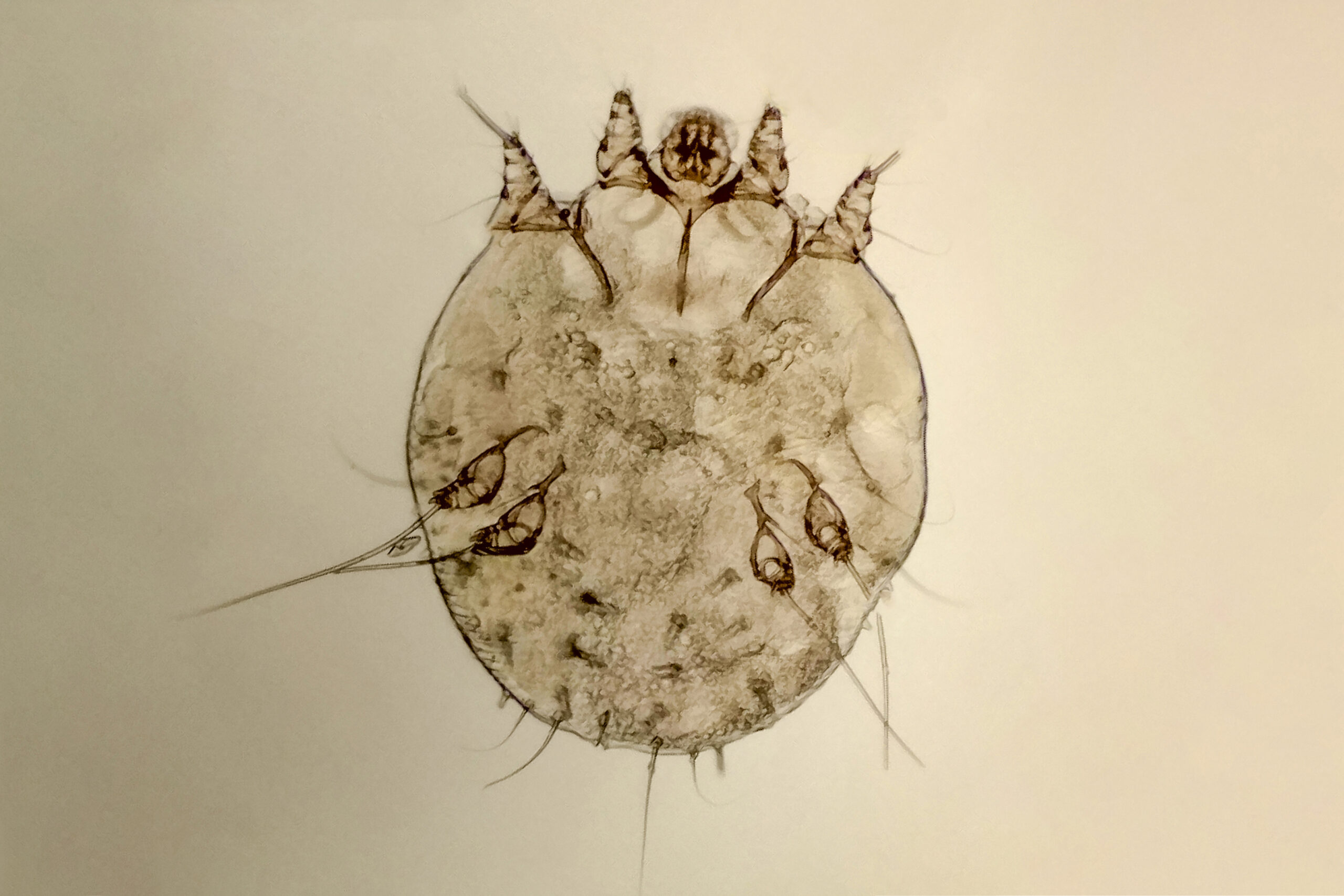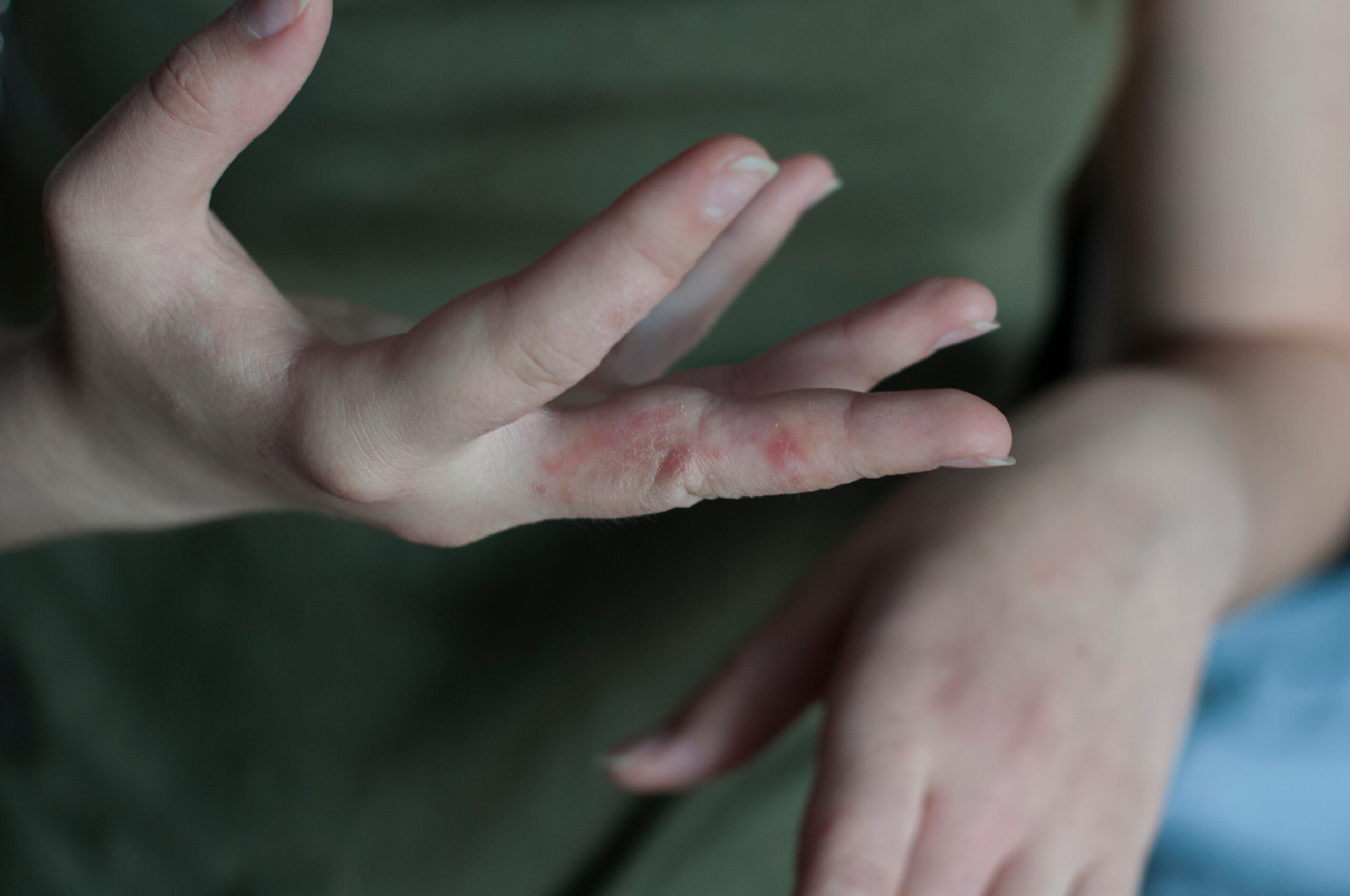Scabies is an infectious disease caused by human itch mite infestation. It is a parasite that only affects humans. It can be quickly passed between people by prolonged skin-to-skin contact or sharing items like towels and bedding. The mite burrows into the external layer of the skin (epidermis), where it lives and lays eggs.
Scabies can affect anyone and appear worldwide. It spreads rapidly under crowded conditions where skin contact is frequent and repetitive, like care homes, prisons, and childcare facilities. A quick handshake or brief touch is usually not enough for mite transmission. Adults most commonly get scabies through sexual activity.
The mites are not visible to the naked eye. The male mites are smaller than the female mites and die shortly after fertilizing the female on the surface of the host's skin. The female mite burrows into the epidermis to lay 2- 3 eggs daily. Her lifespan is about 4 to 8 weeks long. The female mite continues to burrow 0.5 to 5mm a day for the whole duration of her life. The eggs lay in the burrow and hatch after 2-5 days. The larvae stay in the burrow for three weeks until they mature and migrate to the skin surface to repeat the cycle.

People infested with scabies may have visible, characteristic lines and bumps located between their fingers as well as on their wrists, elbows, armpits, waistline, buttocks, and genitalia. Intense itch and rash![]() appear around 4 to 6 weeks after the infestation when the infected person develops an allergic reaction to the mite proteins and feces. Excessive scratching may lead to the formation of sores, which can get infected. The rash can appear anywhere but often starts in skin folds and spreads to surrounding areas. The rash looks like tiny red spots that turn darker with time. It usually appears as larger bumps affecting soles, palms, and scalps in infants and small children.
appear around 4 to 6 weeks after the infestation when the infected person develops an allergic reaction to the mite proteins and feces. Excessive scratching may lead to the formation of sores, which can get infected. The rash can appear anywhere but often starts in skin folds and spreads to surrounding areas. The rash looks like tiny red spots that turn darker with time. It usually appears as larger bumps affecting soles, palms, and scalps in infants and small children.
The organisms of the people who previously have had scabies are already sensitized to mite protein and feces. The symptoms begin much earlier (1-4 days after transmission) in this situation.
Crusted scabies is a severe form of this disease. It can occur in people with impaired immune systems. The number of mites inhabiting the person's body can be increased to thousands or even millions, while regular scabies is an infestation of 10 to 15 mites. This condition is life-threatening and spreads very easily, even through brief skin-to-skin contact. Symptoms of crusted scabies vary slightly from the usual signs of the disease. It often does not cause an itch. People with this severe form of scabies develop dry and crusty patches on their skin.

If it is the first time you get infested, it can take 4-6 weeks for the symptoms to develop. Symptoms like rash and itching appear due to an allergic reaction to the mites' feces. The mites are not visible to the naked eye. Diagnosis of scabies is usually based on a visual examination of the rash by your healthcare professional. The rash usually forms characteristic lines of red bumps. Although burrows can be visible, they can be challenging to locate as only 10-15 mites are causing on the body. If your dermatologist is unsure of the diagnosis, they will take a sample of skin scrapings of the rash to look under a microscope. This allows us to see the mites.
Topical creams, known as scabicides ![]() are most commonly used to treat scabies. These are never over-the-counter and must be prescribed by your healthcare professional. The creams are applied to the whole body from the neck down in adults and can be used on the scalp and head in children and infants. You should be mindful that not all creams are safe for children. The treatment should be applied on clean skin and left on the body for at least 12 hours.
are most commonly used to treat scabies. These are never over-the-counter and must be prescribed by your healthcare professional. The creams are applied to the whole body from the neck down in adults and can be used on the scalp and head in children and infants. You should be mindful that not all creams are safe for children. The treatment should be applied on clean skin and left on the body for at least 12 hours.
Most topical treatments only kill the mites but not the eggs, so the treatment must be repeated when the new mites hatch. The first time a person gets infested, they might not experience any symptoms for 4-6 weeks; however, they can spread scabies during that period. It is essential to treat all the members of the household and sexual contacts. All household members, sexual contacts, and people with whom the infested person had prolonged skin-to-skin contact should be treated at the same time. This is necessary to prevent re-infestation.
Clothing, bedding, and towels used by the infested person or anyone undergoing treatment due to close contact with them over the three days before starting treatment should be washed in hot water, dry-cleaned, or sealed in a plastic bag for at least three days. This is usually sufficient as scabies mites cannot survive more than three days away from a human body and are killed by temperatures above 50.
Topical treatment may not be effective in more severe infestation cases and people with crusted scabies. Tablets with i********n![]() are used to treat patients with persistent scabies. It is not safe for pregnant women and children under ten years old. A dose of i********n is usually repeated after two weeks to treat newly hatched mites.
are used to treat patients with persistent scabies. It is not safe for pregnant women and children under ten years old. A dose of i********n is usually repeated after two weeks to treat newly hatched mites.
It is common that itching and a rash persist after the treatment, even for up to a month, as these symptoms are due to an allergic reaction. Your healthcare professional may suggest other medications to treat these symptoms. Oral or topical steroids and antihistamines can effectively manage the allergic response. Emollients and moisturizers can soothe the skin and speed up the healing process.
If itching continues for a prolonged time and you notice new caves, the treatment may not have been successful and needs to be repeated.
To prevent scabies outbreaks, all persons in contact with an infested person should be treated simultaneously. Treatment should be commenced as soon as possible. You should not be embarrassed to see a healthcare professional about this problem. This could delay the treatment and result in increased transmission. Contracting scabies does not determine personal hygiene. Anyone, regardless of their social status, age, and skin color.
Avoid close body contact and contact with bedding and towels used by the infested person. If you have contracted the disease, avoid having sexual contact until the treatment is finished. All items an infested person uses for three days before treatment should be washed and dried in hot temperatures, dry-cleaned, or sealed in a plastic bag for at least three days to ensure all mites are deactivated. The rooms used by the infested person should be cleaned and vacuumed immediately after the treatment.